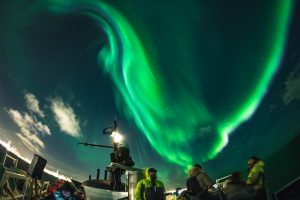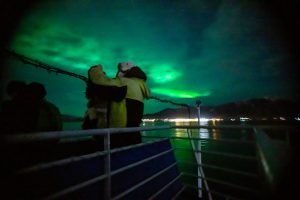What to expect on a Northern Lights boat tour
What to expect on a Northern Lights boat tour
Between September and mid-April, Special Tours offer Northern Lights boat tours in the evenings. The tour lasts for two to two and a half hours and takes our passengers to the fjord of Kollafjörður, north of Reykjavík. There is no need to go very far, only far enough to escape the light pollution of the city. Aboard our boats Andrea and Lilja, our passengers can enjoy a guided tour, snacks and drinks at the cafe, and of course, hopefully, a beautiful Northern Light show and take many photos.
As we leave the harbour, the guide will instruct the passengers about safety and go over everything that is available onboard for their comfort. The use of a microphone allows everybody to hear the guide, wherever they are on the boat, so everyone can move around freely without missing out on anything. Our boats Andrea and Lilja are divided between indoor and outdoor areas. Therefore people have the possibility to go out to look at northern lights, but also to go back in to warm up and rest. They can also borrow the warm overalls there are onboard in order to brave the cold. A cafeteria is open throughout the whole tour and serves all kinds of hot drinks, alcoholic and non-alcoholic beverages, including Brennivín (a typical Icelandic snaps) and Icelandic beers (Gull, Brío) Christmas drink Malt and Appelsín, waffles and snacks. We recommend the combo of hot chocolate and waffle for an instant happiness boost. You can try the Icelandic way, and have your waffle with rhubarb jam and a lot of whipped cream!

During the tour, the guide will share knowledge about the physics behind Northern Lights, where they come from, how they form, their different colors, etc. They will also tell you about the many stories and legends auroras inspired throughout History. They can help you set your camera and will assist you with finding the lights in the sky. A camera is an essential tool when chasing the auroras. Not only it allows you to keep a trace of this magical moment, but it also helps you to find them. Faint northern lights can easily be mistaken for grey clouds by our eyes. Fortunately, your camera would not be fooled and would detect their real colors. It allows you to know where the auroras are while waiting for them to become more active and start showing glowing colors for your eyes too.
While cruising in the fjord of Kollafjörður, we encounter many small islands. The biggest one is Viðey, it is now uninhabited but remains of a village and a school still stand and can be visited in summer. The other islands are nesting grounds for many seabirds, like the Cormorant. The islands of Akurey and Engey also welcome puffin colonies every summer, who come there to nest and breed. This is where the Puffin Express tours of Special Tours takes you to see these fascinating birds. This part of the fjords also offers beautiful views on the snowy mountains around the capital, even by night, like mount Esja, Úlfarsfell, or the ski resort of Bláfjöll.
You can also admire the lights of Reykjavík in the distance. There you cannot miss the concert hall of Harpa, and the church of Hallgrímskirkja. If you visit Iceland around the time of New Year’s Eye, you might be able to see fireworks in the sky of the capital. Icelanders love fireworks and will often continue to fire them long after the 1st of January. They are sold by the Search and Rescue Association in order to fund their operations, which is one more reason to buy big quantities every year.

As we run this tour between September and mid-April, a big part of those tours is going to happen during the heart of the winter. Our passengers should be prepared for all kinds of weather conditions, winter conditions and cold temperatures, strong wind, etc. This is where the overalls and the warmth of the inside of the boat are gladly welcomed. You also need to be well prepare: What to bring on your northern lights cruise. Hot chocolate is also the best remedy when feeling very cold.
As we are only sailing inside the fjord and not to the open ocean, conditions swell-wise are not often rough, and people sensitive to seasickness should not be too bothered by that. But seasickness tablets are offered on board for whose who need them.
What are northern lights and what are the right conditions to see them ?
Northern Lights, also called polar lights or Aurora Borealis are a display of light in the sky, that comes in different colors and different shapes. They are a completely natural phenomenon, and it is impossible to predict if they are going to be out, when, and for how long. Therefore, we can never guarantee sighting. But we only go out when the conditions are favorable.
Favorable conditions here in Iceland to see the Northern Lights are a clear sky and darkness. Darkness is an important factor, as auroras occur all year around at any time of the day or night, but are only visible when it’s dark enough to see them. Therefore, Northern Lights are visible in Iceland as soon as night comes back, after many days of constant daylight in summer. That is why we operate our tours only in the evening from September until mid-April, as the rest of the year has only few hours of darkness or not at all.
Besides darkness, you also want a clear or partly clear sky, which means that our tours are weather dependent, and we only go out when the conditions are good enough in terms of cloud coverage.
Northern lights happen inside an oval-shaped band around the North pole. This band encompasses Iceland, Scandinavia, Siberia, Alaska, Northern Canada, Greenland, etc. If the auroras activity is high, this oval can stretch southwards, and auroras can be seen further south than usual. But Iceland is at a high latitude and therefore always inside this oval, so we can potentially see them even on a low-activity night. And we have in the past seen amazing display of auroras when the forecast showed little activity.
Here you can read: How to read a northern lights forecast.
And some other times, even though all the conditions seem good, auroras simply don’t appear in the sky. Their appearance depends on solar activity, which is something we try to predict but cannot know for sure.
In case we do not see the Northern Lights, all our passengers are invited to join another tour free of charge to try again.
Written by Claire Dutilleul









